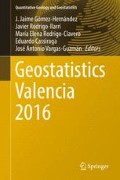Abstract
New methods are required to support unconventional reservoir uncertainty modeling. Unconventional plays add additional complexity with greater uncertainty in direct reservoir measures (e.g., unreliable permeability measures in low-permeability rock) and weakened relationships between currently measurable reservoir properties and production results (production mechanisms may not be well understood). As a result, unconventional plays are often referred to as “statistical plays,” suggesting the reliance on statistical characterization of production distributions as a function of well counts. The application of the techniques described herein can be utilized to integrate all available information to determine appropriate levels of drilling activity to reduce uncertainty to an acceptable level.
Geostatistical approaches provide opportunities to improve the rigor in the dealing with statistical plays. Rigor is introduced through integration of methods that account for representative statistics, spatial continuity, volume-variance relations, and parameter uncertainty.
Analog production data from US shale gas plays are utilized for demonstration. These datasets, after debiasing, are sources for analog production rate distributions and spatial continuity. Given these statistics along with a decision of stationarity, geostatistical workflows provide repeatable uncertainty models that may be summarized over a spectrum of model parameters, drilling strategy, and well counts.
These geostatistical methods do not replace the need for expert judgment, but they improve the rigor of statistical-based approaches that are essential in statistical plays.
Access this chapter
Tax calculation will be finalised at checkout
Purchases are for personal use only
Bibliography
Deutsch JL, Deutsch CV (2010) Some geostatistical software implementation details. CCG Paper 2010-412, Centre for Computational Geostatistics, University of Alberta, Edmonton
Deutsch CV, Journel AG (1998) GSLIB: geostatistical software library and user’s guide, 2nd edn. Oxford University Press, New York
Efron B (1982) The jackknife, the bootstrap, and other resampling plans. Society for Industrial and Applied Math, Philadelphia
Frykman P, Deutsch CV (2002) Practical application of geostatistical scaling laws for data integration. Petrophysics 43(3):153–171
Journel AG (1994) Resampling from stochastic simulations. Environ Ecol Stat 1:63–84
Journel AG, Huijbregts C (1978) Mining geostatistics. Academic, New York City, 600 p
Olea RA, Houseknecht DW, Garrity CP, Cook TA (2011) Formulation of a correlated variables methodology for assessment of continuous gas resources with an application to the Woodford play, Arkoma Basin, eastern Oklahoma. Boletín Geológico y Minero, 122 (4), pp 483–496. ISSN: 0366-0176
Pyrcz MJ, Deutsch CV (2012) Uncertainty models for exploration and appraisal of shale gas. CCG Paper 2012-131, Centre for Computational Geo-statistics, University of Alberta, Edmonton
Pyrcz MJ, Deutsch CV (2014) Geostatistical reservoir modeling, 2nd edn. Oxford University Press, New York, p 448
Pyrcz MJ, Gringarten E, Frykman P, Deutsch CV (2006) Representative input parameters for geostatistical simulation. In: Coburn TC, Yarus RJ, Chambers RL (eds) Stochastic modeling and geostatistics: principles, methods and case studies, vol II and 5. AAPG Computer Applications in Geology, pp 123–137
Society of Petroleum Evaluation Engineers (2010) Guidelines for the practical evaluation of undeveloped reserves in resource plays. Monograph 3
Wilde BJ, Deutsch CV (2013) A methodology for quantifying uncertainty versus data spacing applied to the oil sands. CIM J
Acknowledgments
The authors are appreciative to Chevron Energy Technology Company for support of this work and for allowing this publication. Also, the constructive reviews of two anonymous reviewers are appreciated.
Author information
Authors and Affiliations
Corresponding author
Editor information
Editors and Affiliations
Rights and permissions
Copyright information
© 2017 Springer International Publishing AG
About this chapter
Cite this chapter
Pyrcz, M.J., Janele, P., Weaver, D., Strebelle, S. (2017). Geostatistical Methods for Unconventional Reservoir Uncertainty Assessments. In: Gómez-Hernández, J., Rodrigo-Ilarri, J., Rodrigo-Clavero, M., Cassiraga, E., Vargas-Guzmán, J. (eds) Geostatistics Valencia 2016. Quantitative Geology and Geostatistics, vol 19. Springer, Cham. https://doi.org/10.1007/978-3-319-46819-8_45
Download citation
DOI: https://doi.org/10.1007/978-3-319-46819-8_45
Published:
Publisher Name: Springer, Cham
Print ISBN: 978-3-319-46818-1
Online ISBN: 978-3-319-46819-8
eBook Packages: Mathematics and StatisticsMathematics and Statistics (R0)

